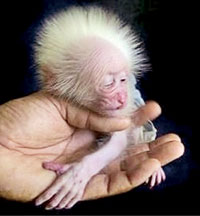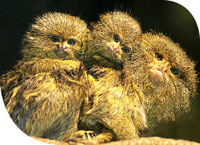|
The planet's smallest
monkey!
If you are wondering weather the tiny and cute creatures featured
here are real, the answer is yes. They do exist. While the distinct
honour of being the world's largest monkeys go to the Mandrill Monkeys,(
relatives of the baboons) , the tiny primates pictured here are the
proud holders of the title, 'the world's tiniest monkeys'.
Aptly called Finger monkeys for their diminutive size, these teeny
weeny monkeys are nothing more than 5-6 inches in size (not including
the tail which can grow up to 8-9 inches. )They are said to be lighter
than an apple,weighing only about 130-140 g: just 140 grams (0.3 pounds)
for males and 120 grams for females.
 Even
though they are called Finger monkeys ,dwarf monkeys or pocket monkeys
by many, their offical name is Pygmy marmoset (Callithrix pymaea). Even
though they are called Finger monkeys ,dwarf monkeys or pocket monkeys
by many, their offical name is Pygmy marmoset (Callithrix pymaea).
These primates belong to the family Callitrichidae, species Cebuella
and genus C. pygmaea.The marmosets are part of a primitive family of
monkeys of the New World, including tamarins too.
Where are these adorable monkeys found? In the rain forests of
Brazil, Peru, Bolivia, Ecuador and Colombia.In fact there are 22 species
are found in Brazil and few in adjacent tropical countries.
They live in both dry and wet forests.They enjoy a view of the water
and prefer forests that may have a riverfront view or else flood-plain.
Small is beautiful and indeed these tiny monkeys are baeutiful in
their own way with furry bodies generally of tawny colouring with black
flecks,large almond shaped eyes and fur around the head similar to a
lion's mane. they have either creamish or white underbellies and black
rings on their tails .
These monkeys have claws, not nails. The claws enable them to climb
the trees in the style of the squirrels, with an amazing skill and
speed. Marmosets rarely descend on the ground and, in resting position,
they stay lain on their belly, with the tail hanging. .
Their diet includes leaves, nectar of flowers, fruits, insects,
spiders, small lizards, and sometimes, small reptiles.

Food habits also include drinking plant sap and eating gum from
trees. They scramble about like squirrels in the deep rain forest and
drink the sap of trees. Since they are so tiny they can climb very high
up in the trees on slender branches to find untapped sources of food -
the sap and gum of trees.
They spend most of the day making inch-deep holes in the bark of
trees with the help of sharp, lower incisors and keep returning to the
holes to gather and
eat gum produced by the trees. They also like to eat grasshoppers and
some other insects when available. However, when the food source
dwindles, the finger monkey shifts to another area. As these monkeys are
highly social animals in the wild, they live in groups of 6-10 made of
an adult pair and their offspring. They communicate with other members
in the group by body language, scent marking, making high pitched
sounds, and grooming each other.The communicating language includes high
pitched clicks, squeaks, whistles and trills. In fact they can make
noises that are so high pitch that humans can't even hear them.
They do have a language of sorts, where certain types of calls and
squeaks signify danger or other important monkey communications.
A female finger monkey can give birth every five months. Usually, the
breeding female gives birth to twins and sometimes, to single babies and
even twins, triplets and quadruplets, after around 135 days gestation
(pregnancy period ). And can you imagine the size of a baby finger
monkey at birth?! About half an ounce.
 The
responsibility of looking after the newborn is shared by both parents
with the father finger monkey looking after the offspring for a couple
of weeks after birth. The
responsibility of looking after the newborn is shared by both parents
with the father finger monkey looking after the offspring for a couple
of weeks after birth.
The parents are ably supported by the older offspring in the group.
The finger monkey is vulnerable to cats, snakes and birds of prey.
When threatened, finger monkeys resort to either vocalizing, chasing or
keeping still till the danger passes off. Unlike other primates, the
species is not endangered, though loss of habitat is a concern. By the
night, marmosets retreat in tree hollows.
These monkeys live in groups, in a well-established hierarchy.
Male pygmy marmosets may make displays of strength and prowess when
confronted by other males and competing for territory.
They do this by raising and flattening their ear tufts, arching their
backs and grimacing while eyeing each other.
Not only males fight for supremacy, but also females engage in
aggressive disputes for the social rank.
The winner is the female who manages to deliver more slaps and
scratches.
It is rather hard to observe them in the wild as they tiny are enough
to be high-up in the trees on small branches. But up there, they have to
be on the lookout for birds of prey.
Would you believe that these cute monkeys are able to jump more than
16 ft or 5 m? Quite a distance for such a small monkey.
Their lifespan in captivity and in the wild differs.
The average lifespan of a finger monkey is 11-15 years, however, some
are known to live up to 25 years.
**************
[Types of monkeys]
Monkeys are classified into two major groups, the New World primates
(South and Central America) and the Old World primates (Asia and
Africa). The major difference, besides living on different continents,
is that the New World primates have tails that can grasp and hold things
while the Old World primates can't do much with their tails and
sometimes have no tail at all.
New World primates do not have versatile opposable thumbs like many
other primates and most Old World primates do.
**************
[Fast facts ]
*Finger monkeys are the smallest monkeys in the world although there
are some primates that are bit smaller (pygmy mouse lemurs and pygmy
tarsiers).
* The largest monkey, the male mandrill (Mandrillus sphinx) or
man-ape of equatorial West Africa has an average head and body length of
24 to 30 inches and a tail length of 2 to 3 inches.
Adult males weigh an average of 55 lb, although some are know to
weigh up to 119 lb and measure 20 in to the shoulder.
*Finger monkeys which are actually pygmy marmosets are also known by
the names ˜pocket monkey' and ˜tiny lion'.
*These cute little primates which are kept by some as exotic pets are
known to a hug and grip on to your finger.
* The finger monkey reaches adult size at two years. The males of
this species are heavier weighing up to 5 oz, as compared to the females
who generally tip the scales at a little over 4 oz. Except for the
difference in height and weight, both the sexes share the same physical
features.
*Finger monkeys are kept as exotic pets .A pet finger monkey needs a
lot of attention. Like other primates, the finger monkey is not
well-behaved initially, but can be trained. The habits that a petfinger
monkey will learn in the first two years, will stay with it through its
life. Finger monkeys are aggressive, little animals, with long sharp
teeth ready to nip at you.
*They are called finger monkeys because they are the size of a human
finger and the fact that they cling to your fingers when you try to hold
them. The common finger monkey however can grow up to 14 inches.
*The common marmoset (Callithrix jacchus) has a very fine silky fur,
hence its scientific name ("splendid fur"). Its ears are covered by
large white tufts.
*The long tail, used for balance when jumping from one branch to
another, is ornamented with 20 white rings. |

